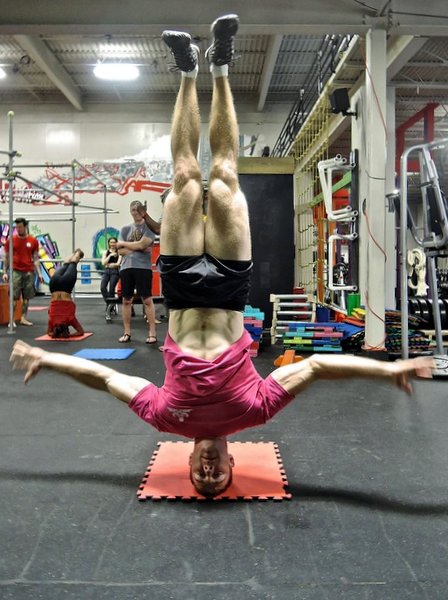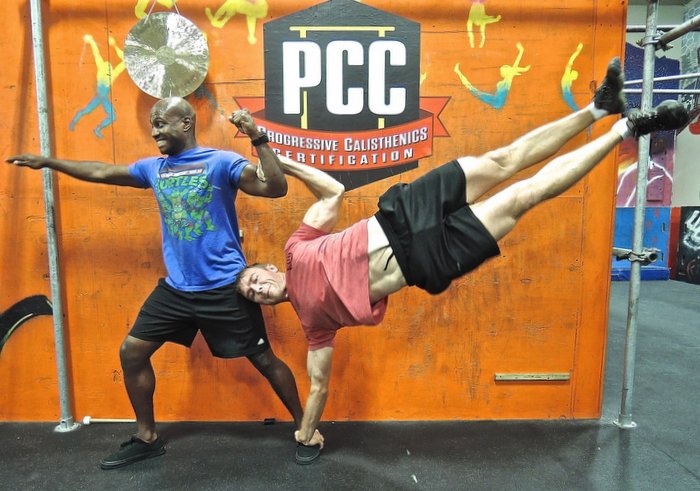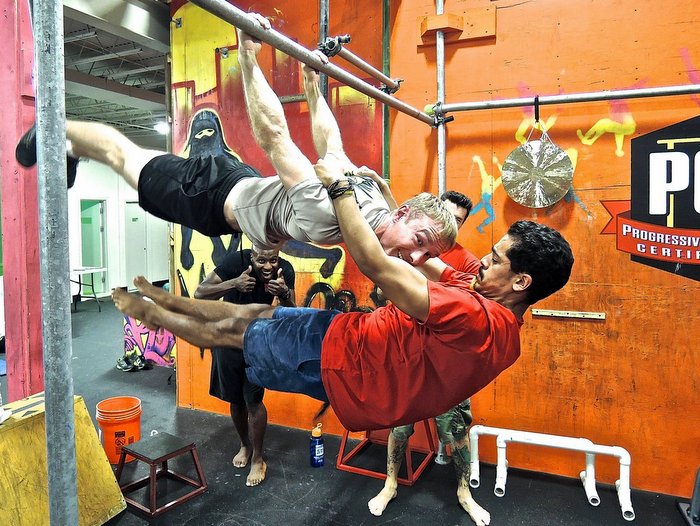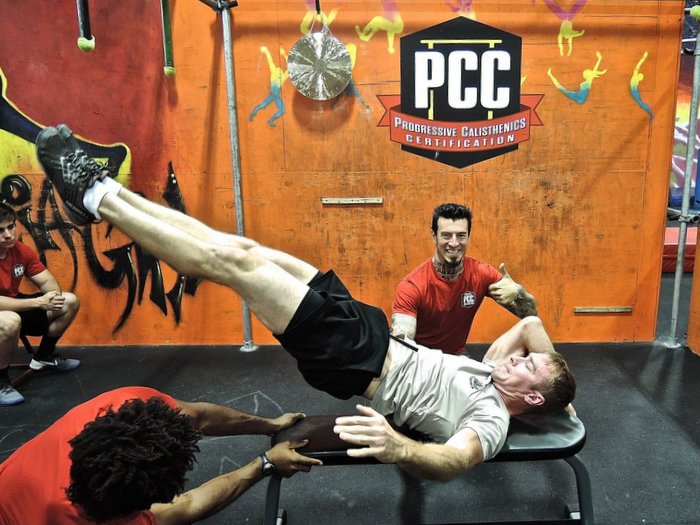Of Bomb Disposal, Tactical Training and the PCC, Scott Underdahl Interview
by Adrienne Harvey, SrPCC, RKC-II, CK-FMS

Dragon Door: How did you first get into fitness and calisthenics?
Scott Underdahl: Fitness overall started later in high school. I was my current height, about 5'10", but I only weighed about 130. I started lifting weights without any formal training. I was doing a lot the wrong way back then and hurt my joints and stuff like that. But I was training with free weights, circuit training, and since I've been in the military, running. About two years ago I got into calisthenics. I saw some videos of guys doing insane bodyweight feats, and I wanted to learn how.
Convict Conditioning was the first book I read on the subject and I was hooked.
Dragon Door: And I saw that you've led military PT for about 10 years too?
Scott Underdahl: About 10 years, it was because I ran "fast" and that equated to "fit" since much of our PT at the time was running. After I got a better understanding of fitness, it evolved. Most of the time I've been at a unit, I usually end up leading the PT in some capacity. The Air Force does a lot of running and light calisthenics—variations of crunches,
push ups and stuff like that. If you have a massive group, it falls into running. But if it’s a small shop, then we have more options like circuits and individual workouts.

Dragon Door: When did you join the military, and can you describe your responsibilities?
Scott Underdahl: I joined 10 years ago last month (August). I just moved down to Florida, and I am now an instructor at our technical training school. Basically, I teach bomb disposal at the joint school for all four services.
Dragon Door: Wow! How did you get into that?
Scott Underdahl: I originally tried to do EOD when I joined the Air Force because one of the recruiters told me about it and I thought it sounded interesting. They added my name to a waiting list, but I couldn’t get an open slot. So when I first joined the military, I first did something else, then they allowed me to cross-train later on. As soon as that window opened, I got a slot and went to school. That was about seven years ago.
Dragon Door: What do you most enjoy about this job?
Scott Underdahl: I enjoy teaching. Although it wasn’t in a formal capacity, I was in the training section of my unit before this one—we needed to learn and train on our job regularly. So, I’d set up scenarios and made sure they catered to the new guys who needed specific training. I enjoy teaching people, especially when they're interested and motivated to learn what’s being taught.
Dragon Door: How did you first hear about the PCC?
Scott Underdahl: I saw it online when I first started getting into calisthenics while finding books and everything else. I had been watching it, and would have liked to have gone sooner. But I was in Missouri at the time, and none of the
workshops were close enough. I originally contacted John Du Cane because my new unit had previously hosted a TRX course, and were talking about hosting a CrossFit certification. Because we have good, open leadership, I pitched the
PCC to them as something we could bring to the unit. Unfortunately we couldn’t swing it because of funding and budget for the fiscal year. But my leadership saw the potential and agreed to send two of us. Thankfully, John worked with us too, so Willie and I could make it to the workshop.

Dragon Door: What did you like the most about the PCC workshop?
Scott Underdahl: I'm an engaged learner. I can watch a video online or read about it, but I get the most benefits when I can get immediate feedback and interact with others—especially for tweaking techniques, tips and learning with everybody there. It’s much better than just reading about it and then trying it on my own.
Dragon Door: Did you set any PRs at the workshop?
Scott Underdahl: My biggest first or PR from the PCC was flagging off of another person, and when Kareem did a front lever off my back lever! (See below.) And while I could reach most of the moves prior to the workshop, I think I was able to improve them all. I liked the term
Danny and
Al used to describe some of the moves when they called them as "fringe moves". Similar to a max, you may have the move on a good day when you're rested, relaxed, and warmed up, but on other days it may look like you've never tried it before!

Dragon Door: What’s a particular tip or cue that really stood out for you?
Scott Underdahl: In the
flag training, I’d never tried the clutch flag before trying to go for the straight arm press flag. At first I couldn’t understand the concept of the grip. But once they explained it as locking the elbow to the hip and using that bone to bone support, I got it and now I can do clutch flags too. Once Danny showed me the hand placement and weight distribution, it clicked and I got it. I was even able to help some of the other people at the workshop with the same tip.
I enjoyed how Al and Danny had a clear curriculum to teach, but were very receptive to any input the group had—and then shared that input with the group. That extra open group involvement was one of the best things about the PCC.
Dragon Door: What moves are you working on now that you've been to the PCC?
Scott Underdahl: My handstand has improved a lot, I can do a freestanding hold in one spot for a few seconds. Inadvertently, I've gotten pretty decent at walking on my hands while trying to hold a handstand. I want to be able to do freestanding handstand push-ups, so I’m practicing holding the handstand while lowering it.
Dragon Door: What are your workouts like now?
Scott Underdahl: I like to try to keep a routine if I can, but I have to adjust my workout schedule because of work. If I can keep a regular schedule for a while, I break it up into upper(push/pulls), lower(squats), and
core/holds workouts. Also since we get to PT our students regularly in the afternoons, I do circuits and running with them to maintain some cardio. On days when I'm not up to doing a full workout, I’ll just work light reps, static holds and stretches for recovery.
Dragon Door: Earlier, you mentioned circuits with your PT groups, can you describe how you’re using them?
Scott Underdahl: I am not a fan of leading workouts where everyone has to do everything the same way, with the same weight, and at the same pace. I am a big proponent of individual PT, but because I have to do groups, I like catered circuits that are somewhat high intensity. Generally there will be a sprints or short runs, with large simple compound exercises like squats, farmer's carries with
sandbags, lunges, push ups, and
pull ups. The exercises are in small enough quantities so that no one station would completely drain somebody, but continued rounds will challenge everybody. There's also a sand hill nearby that we that we run and carry sandbags up and over—the students love to carry heavy stuff uphill. Whatever we end up doing, I give the sequence of what to do, but I tell them as long as they are pushing themselves, they can do it at their own pace.
Dragon Door: What are some of the biggest challenges you see with the people who are training with you in PT?
Scott Underdahl: We get a lot of people with different strengths. I just turned 30 myself, and now I'm working out with these 18,19, and 20-year-olds! I always thought of myself as the young guy, but now they're beating me in running. They have to meet a minimum of PT standards coming in, so they're already fairly fit. The biggest challenge or issue I see though is form and range of motion, especially with
squats. It seems very common anymore that when people squat—with or without weight—most don’t even hit parallel, let alone full depth. This is what I correct most often, but I have also been guilty of short squats in the past. I think the problem comes from people not getting good information. Most of the time they’re working from what someone else said or a magazine, and they never really seem to look much deeper. I know this was my problem in the past. I can look back and see plenty of mistakes and misconceptions I had about exercise and fitness before I actually did research.
Dragon Door: Are you also working towards a BS in exercise science?
Scott Underdahl: I just started. The Air Force highly encourages continued education, so I found a Bachelor’s of Exercise Science and Health program, something that interests me, to transfer into with my Associate's degree from the Air Force. I’ve always learned or found the specific info that I’ve wanted, but haven't done a lot of formal education.
Dragon Door: How did you feel about your Century Test, and how did you prepare for it?
Scott Underdahl: I admired the strictness of the form standards they laid out and that the test was all 100 reps or nothing. I also liked that we didn’t do the
Century Test at the beginning of the workshop—even though we were tired and worn out at the end of the weekend, we still needed to do these very strict form exercises. The standards are higher than the Air Force PT tests that I see. Unfortunately many people in the Air Force think that most push ups look the same and don’t understand or know the importance of form in exercise. That's the reality, but we try to teach good form when we can.
For the Century Test, I took some advice from an article that
Paul Wade wrote. For preparation, he advised being able to do double all the reps on the Century Test. I think that is a good rule of thumb.
I tested second. I get nervous about tests—any test—and wanted to get it done. I don't think I've ever been that intensely focused on my form for bodyweight squats. I knew that doing forty of them wasn't that big of a deal, but I planted my feet and every movement was as deliberate as possible. I used—and shared—one of the sayings we have in our tactical training courses, "slow is smooth, smooth is fast". That phrase seemed to sum up one of the concepts Danny explained to help someone perfect their technique. In our tactical courses, they teach that you don't go for a quick draw and trigger right away, you must learn the movements slowly and deliberately. As you continuously repeat a process, you build the muscle memory, and the speed follows.
I was truly impressed with everyone who showed up at the workshop—there were even some participants who were older than I would have expected. The group did very well overall on the harder exercise variations. People were getting clutch flags and dropping into back levers.

I am grateful that John worked with us so that we could attend. Danny and Al are awesome guys, I've been following them and reading their books for a while. It was really cool to meet them, especially since they turned out to be good people who genuinely care about what they do!
Dragon Door: What's next for you and your training?
Scott Underdahl: Well, I’m going to keep working on my routine. I still like to use some free weights, and change around my exercises to keep improving my strength. I want to master hopping into a freestanding handstand for handstand push ups whenever I want. And the flag and lever are great things I want to be able to just pull out any time—instead of only on good days. There’s room for improvement on my end!
I also want to start doing
personal training. I got my cert last year, but we got the orders to move at the same time, so I haven’t been able to start yet. I am trying to work out something with the base gym to offer free training for those who need help with their PT test and so I could also get some one on one, trainer to client experience.
Back